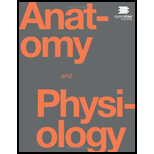
Concept explainers
By clicking on this link (http://openstaxcollege.org/l/fooddigestion) , you can watch a short video of what happens to the food you eat as it passes from your mouth to your intestine. Along the way, note how the food changes consistency and form. How does this change in consistency facilitate your gaining nutrients from food?
To analyze:
The changes in consistency of food down the alimentary canal facilitate gaining nutrients from it.
Introduction:
Digestion is the act of breaking down of food into smaller molecules, by physical and chemical means, to release the nutrients present in them and render it in an absorbable form.
Explanation of Solution
The alimentary canal is aptly designed to convert complex food into simpler forms. This conversion not only breaks down food but also helps to extract the nutrients efficiently from all food that is consumed.
The physical, as well as chemical digestion process, begins right away in our mouth. The chewing of food called mastication mechanically shears the large chunks of food to smaller pieces. It then mixes with saliva to make it into a semi-solid paste called bolus that is easy to swallow. The salivary amylase marks chemical digestion of food by acting on starch. The water hydrates and dissolves much of the food. The mucus lubricates the food for swallowing.
As the food moves down the esophagus it reaches the stomach where the churning action continues to physically shear the bolus further to even smaller particle size. The acid and enzymes produced in the stomach chemically act on food to convert complex molecules into simpler forms. These processes convert the bolus to a form that is more fluid-like called the chyme.
Chyme moves down to the small intestine. The duodenum is the region of major chemical digestion with a host of enzymes acting on the chyme. Physical digestion occurs by the process of segmentation.
Finally, the small molecules in the form of glucose (from sugars), fatty acids and glycerols (from lipids and fats), amino acids (from proteins) and nucleic acids (from nucleoproteins) are released from food. Along with these minerals, electrolytes and vitamins are also rendered free for absorption in the small intestine. The continuous backlash movements along the microvilli on intestinal lumen help in absorption of all these nutrient molecules released from the food.
Had these series of processes to bring about a change in the consistency of ingested food not occurred, the food as a source of nutrients would have been meaningless.
Thus a change in consistency of food from largely sized bites to chewed semi-solid paste (bolus) and then to a fluid-like (chyme) consistency helps in both the movement of food down the alimentary canal and finally the absorption of their nutrients in the intestines.
Want to see more full solutions like this?
Chapter 23 Solutions
Anatomy & Physiology
Additional Science Textbook Solutions
College Physics
Campbell Essential Biology (7th Edition)
Biology 2e
Anatomy & Physiology (6th Edition)
Campbell Biology in Focus (2nd Edition)
Study Guide for Campbell Biology
- Figure 34.19 Which of the following statements about digestive processes is true? Amylase, maltaseT and lactase in the mouth digest carbohydrates. Trypsin and lipase in the stomach digest protein. Bile emulsifies lipids in the small intestine. No food is absorbed until the small intestine.arrow_forwardDigestion is completed and products are absorbed in the _________. a. mouth b. stomach c. small intestine d. large intestinearrow_forwardFigure 16.7 Which of the following statements about the digestive system is false? a. Chyme is a mixture of food and digestive juices that is produced in the stomach. b. Food enters the large intestine before the small intestine. c. In the small intestine, chyme mixes with bile, which emulsifies fats. d. The stomach is separated from the small intestine by the pyloric sphincter.arrow_forward
- Figure 34.11 Which of the following statements about the digestive system is false? Chyme is a mixture of food and digestive juices that is produced in the stomach. Food enters the large intestine before the small intestine. In the small intestine, chyme mixes with bile, which emulsifies fats. The stomach is separated from the small intestine by the pylloric sphincter.arrow_forwardBile has a role in _________ digestion and absorption. a. carbohydrate c. protein b. fat d. amino acidarrow_forwardList the organs and accessory organs of the digestive system. On a separate piece of paper, list the main functions of each organ.arrow_forward
 Biology 2eBiologyISBN:9781947172517Author:Matthew Douglas, Jung Choi, Mary Ann ClarkPublisher:OpenStax
Biology 2eBiologyISBN:9781947172517Author:Matthew Douglas, Jung Choi, Mary Ann ClarkPublisher:OpenStax Concepts of BiologyBiologyISBN:9781938168116Author:Samantha Fowler, Rebecca Roush, James WisePublisher:OpenStax College
Concepts of BiologyBiologyISBN:9781938168116Author:Samantha Fowler, Rebecca Roush, James WisePublisher:OpenStax College
 Comprehensive Medical Assisting: Administrative a...NursingISBN:9781305964792Author:Wilburta Q. Lindh, Carol D. Tamparo, Barbara M. Dahl, Julie Morris, Cindy CorreaPublisher:Cengage Learning
Comprehensive Medical Assisting: Administrative a...NursingISBN:9781305964792Author:Wilburta Q. Lindh, Carol D. Tamparo, Barbara M. Dahl, Julie Morris, Cindy CorreaPublisher:Cengage Learning Human Biology (MindTap Course List)BiologyISBN:9781305112100Author:Cecie Starr, Beverly McMillanPublisher:Cengage Learning
Human Biology (MindTap Course List)BiologyISBN:9781305112100Author:Cecie Starr, Beverly McMillanPublisher:Cengage Learning





